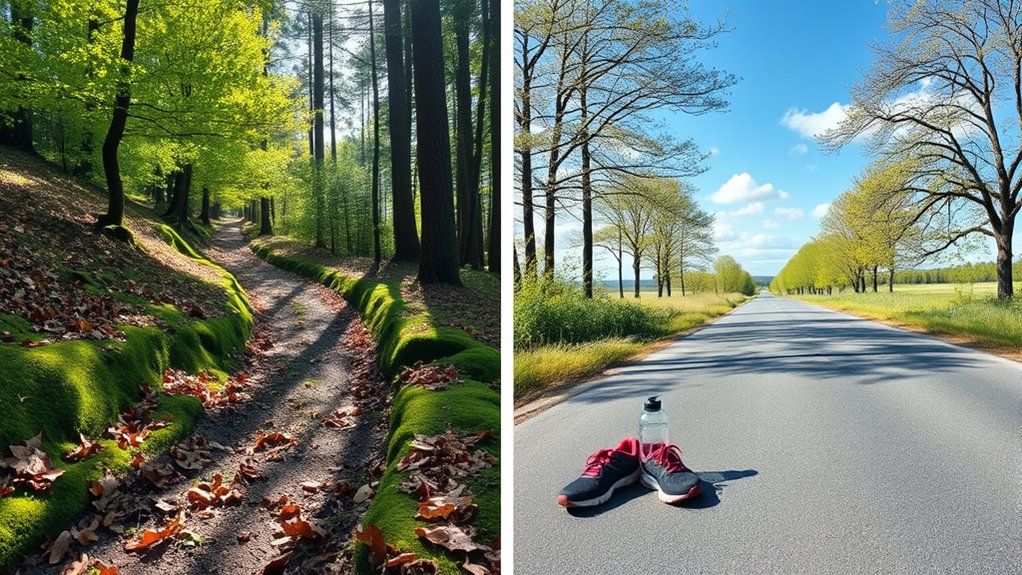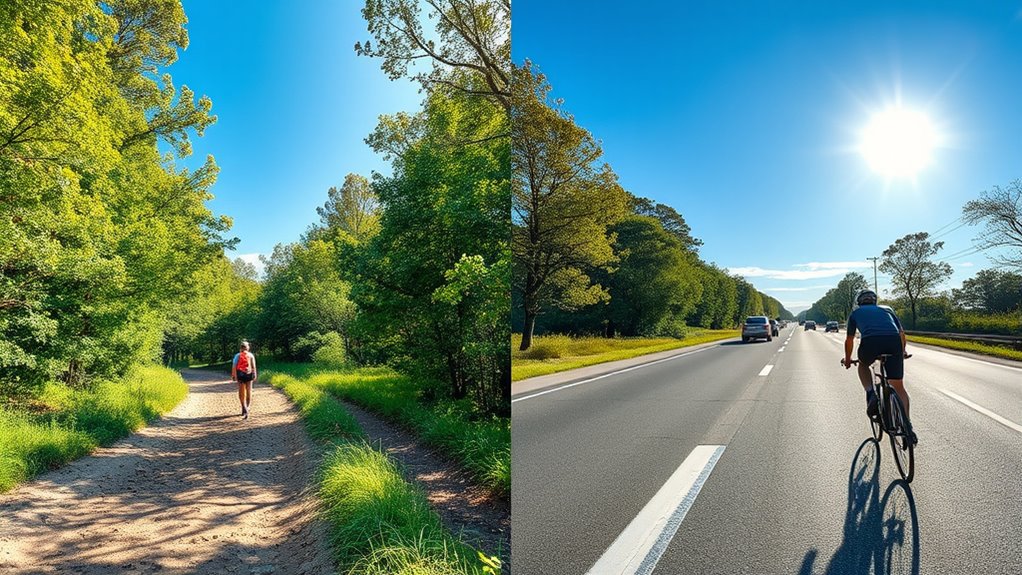Running on trail and road back-to-back reveals different physical and mental impacts. Trail running challenges your strength, balance, and focus with uneven terrain and obstacles, boosting resilience and engagement. Road running offers a steady, predictable surface that improves cardiovascular endurance but requires less mental effort. Comparing both experiences shows how each boosts different benefits. To discover how these surfaces affect your performance and mindset, continue exploring the insights from this experiment.
Key Takeaways
- Comparing performance metrics, terrain impact, and mental engagement highlights differences between trail and road running.
- Environmental factors like weather and wildlife encounters influence safety, gear needs, and overall experience in back-to-back runs.
- Terrain variability affects physical effort, injury risk, and gear requirements, emphasizing tailored preparation for each environment.
- Trail running offers scenic variety and mental challenge, while road running provides consistency and endurance focus.
- Alternating trail and road runs balances physical intensity, recovery, and mental stimulation for comprehensive training benefits.
Planning the Experimental Framework

To effectively compare trail and road running, you need to carefully plan your experimental framework. Start by considering wildlife encounters, which can vary greatly between the two environments and influence your experience and safety. Decide how you’ll document these interactions and their effects on your run. Weather impacts are also vital; rain, heat, or wind can differ substantially between trail and road settings, affecting performance and comfort. Set clear parameters for the experiment, such as time of day, temperature, and humidity, to guarantee consistency. Additionally, plan for how you’ll record environmental conditions and any wildlife sightings. Incorporating environmental factors into your setup can also help you understand how different conditions influence your run, leading to more comprehensive results. Using proper recording tools can ensure accurate data collection for your comparison. Pay attention to vibrational energy and how it might vary between environments, as it can subtly impact your performance and perception. By establishing these factors beforehand, you’ll gather meaningful data, making your comparison more accurate and insightful. Incorporating high-quality projectors into your setup can also enhance your viewing experience during post-run relaxations, providing clearer visuals for reviewing your data and footage.
Selecting the Routes and Terrain Types

When choosing your routes, consider what criteria matter most, like difficulty level, scenery, or safety. Think about how terrain diversity can impact your experience, whether you prefer flat trails or rugged paths. Balancing these factors helps you select the best terrain for your goals and preferences. Additionally, understanding how different terrain types can influence energy expenditure and safety can help optimize your outdoor experience. For example, selecting route difficulty levels that suit the environment can enhance your overall experience. Being aware of potential risk factors associated with various terrains allows for better planning and accident prevention.
Route Selection Criteria
Choosing the right route depends on evaluating both terrain and your goals. Consider how wildlife encounters might influence your decision—some routes are more active with animals, requiring extra caution and adherence to trail etiquette. If wildlife sightings are a priority, select trails known for their natural habitats, but always respect animals’ space. Your fitness level and experience also matter; technical or challenging terrain demands different preparation than smoother paths. Think about your purpose—whether for training, leisure, or photography—and pick routes that align. Visibility, trail type, and expected traffic help guide your choice. Ultimately, selecting a route involves balancing terrain difficulty with your comfort zone, keeping safety and respect for nature top of mind. Wildlife activity can vary depending on the route, so understanding local ecosystems can help you plan accordingly. Additionally, considering the trail surface can influence both your safety and overall experience, especially when navigating different terrain types.
Terrain Diversity Considerations
Considering terrain diversity is crucial when selecting routes, as different landscapes offer unique challenges and experiences. Trail terrain varies from rocky paths to muddy sections, demanding different skills and gear. Road surface, on the other hand, ranges from smooth asphalt to uneven gravel, affecting speed and comfort. When choosing your routes, keep these points in mind:
- Assess trail terrain for technical difficulty and safety.
- Consider road surface conditions to ensure suitable equipment and pace.
- Balance terrain variety to maximize adventure and minimize fatigue.
Preparing Gear and Equipment

Preparing your gear and equipment is essential to guarantee a safe and enjoyable adventure, whether you’re hitting the trail or the road. Focus on gear organization to keep everything accessible and avoid last-minute scrambling. Use practical storage solutions, like packing cubes or designated compartments, to stay organized. Prioritize equipment durability by selecting gear that withstands the demands of your route, especially for trail conditions where ruggedness matters. Check all gear beforehand, ensuring nothing is damaged or missing. Lightweight, high-quality items save space and reduce fatigue. Remember to pack essentials tailored to your activity, weather, and terrain. Proper preparation not only boosts your confidence but also minimizes surprises, helping you concentrate on enjoying the experience rather than worrying about equipment failures.
Daily Activities and Nutrition Strategies

Organizing your gear sets the stage for a smooth experience, but maintaining your energy and focus throughout the day depends on your daily activities and nutrition strategies. Effective hydration strategies ensure you stay fueled and prevent fatigue, so sip water regularly and include electrolytes. Nutritional timing is key; eat balanced meals before your activity and plan small, carbohydrate-rich snacks during your effort to sustain energy. Consider these points:
- Prioritize consistent hydration to avoid dehydration.
- Time your meals and snacks to optimize energy levels.
- Incorporate nutrient-dense foods that support endurance and recovery.
Managing Physical and Mental Endurance

Maintaining both physical and mental endurance is essential to push through challenging terrain and stay focused on your goals. To do this, optimize your gear to reduce fatigue and prevent injuries; lightweight, well-fitted shoes and moisture-wicking clothing make a big difference. Prioritize mental resilience by breaking the distance into smaller segments and celebrating each milestone. Staying hydrated and fueling properly helps sustain energy levels, reducing mental fatigue. Practice mindfulness or breathing techniques during your run to stay centered and focused. Building endurance isn’t just about physical training—it’s about preparing your mind to handle discomfort and setbacks. With effective gear optimization and mental resilience, you’ll be better equipped to maintain performance and enjoy the journey, whether on trail or road.
Observing Environmental and Safety Factors

Observing environmental and safety factors is crucial to ensuring a secure and enjoyable run, whether you’re on trail or road. Being aware of your surroundings helps you anticipate risks like wildlife encounters or sudden weather changes. Here are key points to keep in mind:
- Check weather forecasts before heading out, as weather unpredictability can turn a pleasant run into a hazardous situation.
- Stay alert for wildlife encounters, which are more common on trails but can occur on roads near natural habitats.
- Wear appropriate gear and carry essentials, such as water and a phone, to respond quickly to emergencies or unexpected conditions.
Tracking Performance Metrics and Experiences

Tracking your performance metrics and experiences allows you to monitor progress and identify areas for improvement. On trails, you’ll notice how trail challenges—such as uneven terrain, elevation changes, and technical sections—impact your pace and effort. Recording your times, heart rate, and perceived difficulty helps you understand how well you adapt to these obstacles. On roads, the scenery often remains constant, but tracking your speed, stride efficiency, and fatigue levels reveals how consistent your performance is over flat, predictable surfaces. Comparing these metrics across both environments highlights your strengths and limitations in different conditions. Keeping detailed logs of your experiences also helps you recognize mental and physical responses to trail challenges versus the monotony of road scenery, guiding your training and race strategies.
Comparing Challenges and Enjoyment Levels

When you compare the challenges and enjoyment levels of trail running versus road running, you’ll notice significant differences in how each environment stimulates your mind and body. On trails, you face uneven terrain, roots, and unpredictable obstacles, which demand more focus and effort. This often makes trail running more mentally engaging but physically demanding. Conversely, road running offers a smoother, more predictable surface that’s easier on your footwear choice but may become monotonous over time. Trail maintenance impacts the experience too—less predictable paths can be more enjoyable or frustrating, depending on your mindset.
- Trail running requires more attentive footwear choice to navigate rough terrain safely.
- The unpredictability of trails enhances mental engagement but increases physical challenge.
- Road running’s simplicity offers a more consistent, less mentally taxing experience.
Analyzing the Physical and Psychological Benefits

Engaging in trail or road running offers distinct physical and psychological benefits that can enhance your overall well-being. Trail running challenges your muscles and balance, boosting strength and coordination, while road running improves cardiovascular health through consistent pace. Psychologically, both activities reduce stress and elevate mood. Trail running fosters mental resilience by requiring focus on uneven terrain, while road running’s steady rhythm can be meditative. Proper hydration strategies are vital to sustain performance and prevent fatigue in both environments. Here’s a comparison:
| Benefit | Trail Running | Road Running | Common Focus |
|---|---|---|---|
| Physical | Builds strength, agility | Improves endurance | Hydration strategies |
| Psychological | Enhances mental resilience | Reduces stress | Mental resilience |
| Terrain | Uneven, challenging | Flat, predictable | Consistency |
| Mindset | Focus on adaptability | Focus on pace and rhythm | Mindfulness |
Reflecting on Insights and Future Outdoor Plans

Reflecting on your recent trail and road running experiences allows you to recognize the unique benefits each offers and identify areas for growth. You might notice that gear innovation plays a big role in enhancing your performance and comfort, whether on rugged trails or smooth pavement. Trail aesthetics, with their diverse scenery, keeps your runs engaging and inspiring. To plan better outdoor adventures, consider these points:
- Invest in trail-specific gear that improves durability and traction.
- Mix trail runs with road sessions to balance intensity and recovery.
- Prioritize scenic routes to boost motivation and enjoyment.
Frequently Asked Questions
How Do Weather Conditions Impact the Overall Experience and Safety?
Weather conditions greatly influence your experience and safety during outdoor activities. Poor weather adaptability, like rain or snow, can make trails slippery and reduce trail visibility, increasing your risk of falls or getting lost. On the other hand, clear weather enhances visibility and safety. Always check forecasts beforehand, dress appropriately, and be prepared to adjust your plans to ensure a safe, enjoyable adventure regardless of weather challenges.
What Are Common Injuries or Issues Encountered During Such Back-To-Back Activities?
You might think your muscles and joints are invincible, but after back-to-back activities, you’re likely to face severe muscle strains and joint pain that feel like they’ve been hit by a freight train. Pushing through can lead to overuse injuries, blisters, or even stress fractures. Make sure to listen to your body, stretch properly, and give yourself time to recover, or risk turning your weekend adventure into a lingering pain fest.
How Does Sleep Quality Vary Between Trail and Road Days?
You might notice that your sleep quality varies depending on your activity level. After a trail day, your sleep hygiene can improve because of the physical exertion, making it easier to fall asleep. However, fatigue management becomes essential to avoid restless nights. On road days, you might experience lighter sleep due to mental fatigue or discomfort. Prioritizing good sleep hygiene helps you recover better, no matter the activity.
What Mental Strategies Help Maintain Motivation Throughout Both Activities?
To stay motivated during your activities, focus on building mental resilience by reminding yourself of your goals. Use goal visualization to picture your success and how good you’ll feel once you’ve achieved it. Break tasks into smaller steps, celebrate progress, and stay positive. When challenges arise, remind yourself of your purpose and push through. These strategies keep your mind strong and motivated, helping you enjoy both trail and road days fully.
How Do Local Wildlife or Environmental Factors Influence Safety Precautions?
Wildlife encounters and environmental hazards definitely influence your safety precautions. Studies suggest that being aware of local wildlife behavior helps you stay alert and avoid surprises. You might carry bear spray or make noise to deter animals, and check weather forecasts for environmental hazards like storms or flooding. Recognizing these factors guarantees you’re prepared, reducing risks during your activities. Staying informed about local conditions keeps your adventure safe and enjoyable.
Conclusion
As you step off the trail and onto the open road, you realize each path offers its own adventure—dusty footsteps on rugged dirt versus the steady rhythm of pavement beneath your wheels. The sun warms your face, and the wind whispers tales of endurance and discovery. Whether you crave the serenity of nature or the thrill of speed, this experiment deepens your appreciation for both. Embrace each journey, and let it inspire your next outdoor escape.









